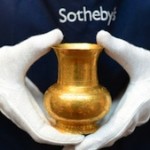 In the wake of the Western expansion, a fast growing number of non-European artefacts entered the European market. They initially made their way into princely cabinets of curiosities. Enabled by the forced opening and exploitation of more and more parts of the world and pushed by social and technological changes of the time, the 18th century brought a boom of the market of non-European artefacts in Europe. This came along with the emergence of a broader collecting culture and the development of a rich museumscape. This market and its development in terms of methods and places of exchange and monetary and ideological value of the objects are in the focus of an international symposium that will take place in Berlin, October 13th-15th.
In the wake of the Western expansion, a fast growing number of non-European artefacts entered the European market. They initially made their way into princely cabinets of curiosities. Enabled by the forced opening and exploitation of more and more parts of the world and pushed by social and technological changes of the time, the 18th century brought a boom of the market of non-European artefacts in Europe. This came along with the emergence of a broader collecting culture and the development of a rich museumscape. This market and its development in terms of methods and places of exchange and monetary and ideological value of the objects are in the focus of an international symposium that will take place in Berlin, October 13th-15th.The aim of this symposium, organised by the Institute for Art History in cooperation with the Center for Art Market Studies at Technical University Berlin, in collaboration with the Institut d’histoire moderne et contemporaine (CNRS) and the Labex TransferS (PSL) in Paris, is to examine how the market for non-European artefacts developed between 18th and 20th century and to which extend it was entangled with the history of museums and private collections. The following five topics will serve as main axis: actors and networks, places of purchase and trade, transfer and transport, prices and value and expertise. The axes are entangled and should not be regarded as separated topics.
1. Actors and networks
Who were the actors of the market (e.g. art dealers, commercial agents, carriers but also diplomats, travellers, expats, missionaries or military as well as museums and collectors)? Which regional specifications can be identified? Who were the key figures of the market(s)? Which networks can be spotted? How did they work?
2. Places of purchase and trade
What were the centres of the purchase and/or trade of art objects (in the countries of origin as well as in Europe)? How did they develop in the course of the period of examination? Which significance did the primary markets and their political/social development have for the European market? Did the European market turned into the primary market at a certain time? What were the main places for purchase and trade in Europe (e.g. auctions houses, galleries, private houses)? What marketing methods can be identified?
3. Transfer and transport
What were the (political, social, technological) circumstances of the objects purchase? To which extend did technological developments (e.g. establishment of railway lines) influence the market offer? How were the objects brought to Europe (e.g. export and import regulations, methods of transport)?
4. Prices and value
Which payment methods or methods of exchange did exist? How did they impact the value of objects? How was the value of an object determined? To which extend did this value change in space and time (difference between primary and secondary market; development in the course of time)? Despite the monetary value of a price: which other function in the act of purchase can be identified (e.g. legitimation of possession)? And to which extend did the change of the price and value shape the European collections? Here, we are especially interested in the shift from an economy of looting or/and bazaar in the countries of origin to the pricing and “rational” marketing after the arrival and commercialisation of the objects in Europe.
5. Expertise
How did the perception of and the knowledge about non-European art develop? How was the knowledge generated and transferred? Which role did individual actors (e.g. dealers, museums, collectors) play in the development of the perception of the objects? To which extend did the development of expertise influence the market offer, the display of the objects and the character of the collections?
Submission guidelines
Papers should be a maximum of 20 minutes in length, and preference will be given to proposals that stimulate dialogue and engage with broader topics.
Please send proposals (max. 300 words) with a short academic CV to c.howald@tu-berlin.de by 15 February 2016 at the latest.
Selected speakers will be notified by 15 March 2016. Financial assistance with travel expenses for speakers may be available (subject to grant approval).
The focus of the investigation will be set on the development between 18th and 20thcentury. Papers exploring the market development before 18th century and especially those comparing the development before and after 1700 are also welcome.
Conference language is English.
Convenors
- Prof. Dr. Bénédicte Savoy (TU Berlin),
- Dr. Charlotte Guichard (CNRS, IHMC, Paris),
- Dr. Christine Howald (TU Berlin)
All the Beauty of the World: The Western Market for non-European Artefacts (18th-20th century)
13.10. – 15.10.2016

Leave a Reply
You must be logged in to post a comment.